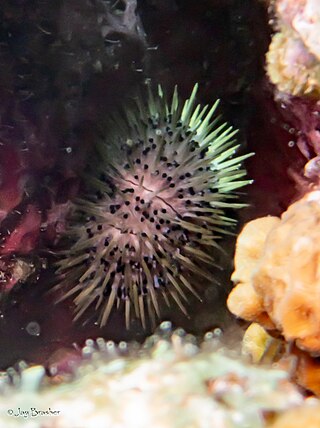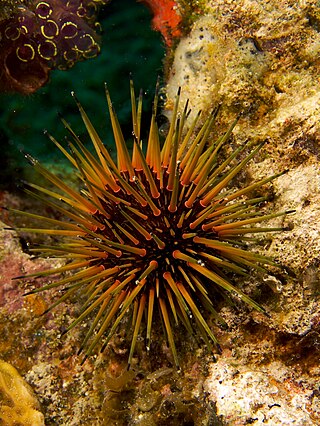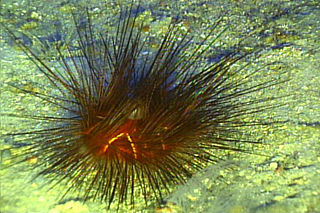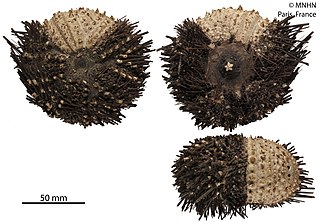
Lord Howe Island Marine Park is the site of Australia's and the world's most southern coral reef ecosystem. The island is 10 km in length, 2 km wide and consists of a large lagoonal reef system along its leeward side, with 28 small islets along its coast. In 1999, the waters within three nautical miles of Lord Howe Island (465.45 km2) were declared a marine park under the NSW Marine Park Act 1997 to protect its unique marine biodiversity, with the park currently being managed by the New South Wales Marine Parks Authority. Both Lord Howe Island and Balls Pyramid are incorporated within the three nautical miles protected by the state marine park. Both marine parks complement the island's status as a World Heritage Site.

The diadema urchin or blue-black urchin is a species of tropical sea urchin, member of the Diadematidae family.

Diadema is a genus of sea urchins of the family Diadematidae.

Diadema antillarum, also known as the lime urchin, black sea urchin, or the long-spined sea urchin, is a species of sea urchin in the family Diadematidae.

Lytechinus variegatus, commonly called the green sea urchin or the variegated sea urchin, is a species of sea urchin that can be found in the warm waters of the western Atlantic Ocean and Caribbean Sea.

Toxopneustes pileolus, commonly known as the flower urchin, is a widespread and commonly encountered species of sea urchin from the Indo-West Pacific. It is considered highly dangerous, as it is capable of delivering extremely painful and medically significant stings when touched. It inhabits coral reefs, seagrass beds, and rocky or sandy environments at depths of up to 90 m (295 ft). It feeds on algae, bryozoans, and organic detritus.

Echinometra mathaei, the burrowing urchin, is a species of sea urchin in the family Echinometridae. It occurs in shallow waters in the Indo-Pacific region. The type locality is Mauritius.

Lytechinus williamsi, the jewel urchin, is a sea urchin in the family Toxopneustidae. It occurs on shallow reefs off the coasts of Panama, Belize, the Florida Keys and Jamaica.

Echinometra lucunter, the rock boring urchin, is a species of sea urchin in the family Echinometridae. It is found in very shallow parts of the western Atlantic Ocean and the Caribbean Sea.

Echinometra viridis, the reef urchin, is a species of sea urchin in the family Echinometridae. It is found on reefs in very shallow parts of the western Atlantic Ocean and the Caribbean Sea.

Astropyga magnifica is a species of sea urchin of the family Diadematidae. In life, their test is covered with spines. Astropyga magnifica was first scientifically described in 1934 by Austin Hobart Clark.
Breynia desorii is a species of sea urchins of the family Loveniidae. Their armour is covered with spines. Breynia desorii was first scientifically described in 1851 by Gray.

Breynia elegans is a species of sea urchins of the family Loveniidae. Their armour is covered with spines. Breynia elegans was first scientifically described in 1948 by Ole Theodor Jensen Mortensen.
Breynia neanika is a species of sea urchins of the family Loveniidae. Their armour is covered with spines. Breynia neanika was first scientifically described in 1982 by McNamara.
Breynia vredenburgi is a species of sea urchins of the family Loveniidae. Their armour is covered with spines. Breynia vredenburgi was first scientifically described in 1907 by Anderson.

Eucidaris thouarsii, the slate pencil urchin, is a species of cidaroid sea urchins that inhabits littoral regions of the East Pacific Ocean.

Clypeaster australasiae, the Australasian sand dollar, is a species of sea urchins of the family Clypeasteridae. Their armour is covered with spines. Clypeaster australasiae was first scientifically described in 1851 by Gray.

Diadema mexicanum is a species of long-spined sea urchin belonging to the family Diadematidae. It is native to the Pacific coast of Mexico, Costa Rica, El Salvador, Nicaragua and Panama.

Parechinus angulosus, the Cape urchin, is a sea urchin in the family Parechinidae endemic to southern Africa. It is the only species in the genus Parechinus.

Mespilia globulus, the globular sea urchin, sphere sea urchin, or tuxedo urchin, is a sea urchin occurring in tropical shallow reef habitats. The specific name refers to a small ball or spherule, describing its overall shape/morphology. It is the only species in the genus Mespilia.


















